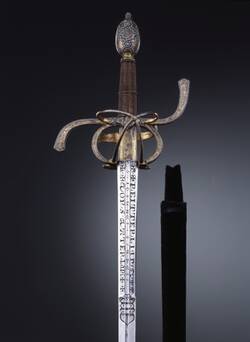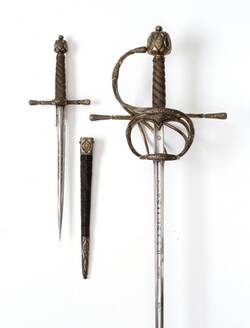The rapiers and daggers in this display case also date from the late-sixteenth or early-seventeenth century. They are Italian and German ceremonial weapons, decorated in gold and silver, with rigorously stylised, almost abstract foliage arabesques.
Weapons, like suits of armour, followed various fashions. With time the designs of the guards on rapiers, epees and daggers became more and more complex. The examples you see here have elegant metal inlays worked into the metal surfaces of the hilts and cross-guards.
The main exhibit in this display case – No. 6 – is a rapier from the early seventeenth century. The guard has gold inlays and is decorated with curvilenear ornamentation, foliage, and a string-of-beads design, as though the hilt and cross-guard were covered with a fine fabric. The blade was made in the German town of Solingen. The craftsman can be identified by his mark, a king’s head. It was Johannes Wundes, a cutler who was famous throughout Europe in his day. The rapier blade bears an inscription in a beautiful inlay: “Love the truth and fight chivalrously for the Fatherland.”
The blades of another rapier-and-dagger set displayed here were also made in Solingen. They have been ascribed to the master craftsman, Peter Wersberg.
Despite the superiority of firearms – or perhaps for that very reason – fencing remained a courtly activity, even in the seventeenth century. Daggers and rapiers were still the nobleman’s chivalrous accessory and continued to be used for duelling. The splendid weapons you see here are impressive evidence of that.

